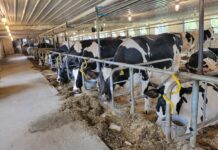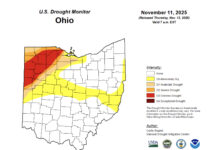Mastitis and lameness are the two most costly health issues on dairy farms today. Cost of treatment for mastitis is certainly important, but the major factor to the cost of mastitis is the loss of milk production and the cow if she has to be culled from the herd.
Now is a good time to review the mammary health of the herd because mastitis is more prevalent in the summer.Heat stress
Pathogens need adequate food source (organic material), proper temperature, and adequate moisture to survive and populate. Increased teat end exposure to pathogens occurs in the summer due to the increased growth of pathogens in bedding with elevated temperatures and the cow may also have less resistance due to heat stress.
Relative to stage of lactation, cows are most susceptible to intramammary infections at dry off and at calving. First lactation animals should have less incidence of mastitis than older cows. Thus, with all of these aspects in mind, monitoring the mammary health of the herd is very important. At least monthly analysis of the somatic cells in milk for each cow should occur, all treatments for mastitis should be recorded, work with your veterinarian to determine if milk cultures should be done when having persistent mastitis issues, and cow-side tests, such as the California Mastitis Test (CMT), can be useful. The major focus should be to prevent intramammary infections from occurring, but quick identification of infection and proper treatment can reduce the severity and duration of the infection. What you can do. Some guidelines for using management records for improving the mammary health of the herd are: The goal for the herd should be less than 200,000 cells/mL of milk, with under 150,000 cells/mL being a more preferred goal. Use the overall average from management records and the bulk tank records from the milk processor to routinely assess your herd’s mammary health. As was mentioned earlier, loss of milk production is the major cost to mammary infection. Milk loss caused by an infection in older cows is greater than for first-lactation cows, a loss of about 400 and 200 pounds/lactation, respectively, for each increase in linear somatic cell score (SCS) above 2 [or doubling of somatic cell count (SCC)] (Table 1). For example, an aged cow with an average SCS of 5 would produce about 1,200 pounds less milk, equating to $216 with milk at $18/hundredweight. This loss in milk revenue does not include the loss in quality premiums. Compare the herd’s SCC just prior to dry off to the herd’s SCC after calving. Is the dry cow treatment effective? Are cows getting infected during the dry period? Are infections in the previous lactation being cured during the dry period? Monitor the herd’s infection status by stage of lactation. Are infections more prevalent at certain days in milk, and if so, can this be associated with a change in housing or some management practice? Use reports that provide the amount of somatic cells contributed in the bulk tank by infected cows, especially important for identifying those persistency infected. The milk from these cows may need to be left out of the bulk tank, or these cows may need to be culled. These cows may be causing the loss of quality premiums paid by the milk processor. We generally categorize levels of SCC at 0 to 283,000 cells/mL as low, 284,000 to 1,130,000 as medium, and more than 1.13 million as high. The goal should be to have about 85 percent of the herd in the low category and less than 5 percent in the high category. Even with the best preventive measures, clinical mastitis still occurs on dairy farms. A goal is for less than three new infections per month for a 100-cow herd (3 percent). Also, less than 5 percent of the herd should be culled due to mastitis. Using production records to monitor mammary health of the herd is very important for the health of the herd, shipping high quality milk, and for profitability of the dairy enterprise. (The author is a professor and Extension dairy specialist at Ohio State University.)












